
A
Lineage of Honor
The
Washington Artillery Enters the 20th Century
"Fit Via Vi"
by
Glen C. Cangelosi, M.D.
copyright 2004
After the Civil War, two
attempts were made to reorganize the Battalion Washington Artillery when sufficient numbers of members had returned to the
Crescent City after the Southern army's surrender, but the Federal commander
(ex-Union General Philip H. Sheridan) dispersed both meetings and prohibited
Confederate military organizations. So the battalion took on the aspects of a fraternal and
benevolent society (the Benevolent Association of
the Washington Artillery). It was not until 1870 that the organization was allowed to
reform again as a military unit. Three batteries were formed under Colonel
Walton using his same wartime officers and members, but the organization's
reduced numbers could only muster three batteries known as A, B and C, which
were successors to the Third, Fifth and First Companies, respectively.
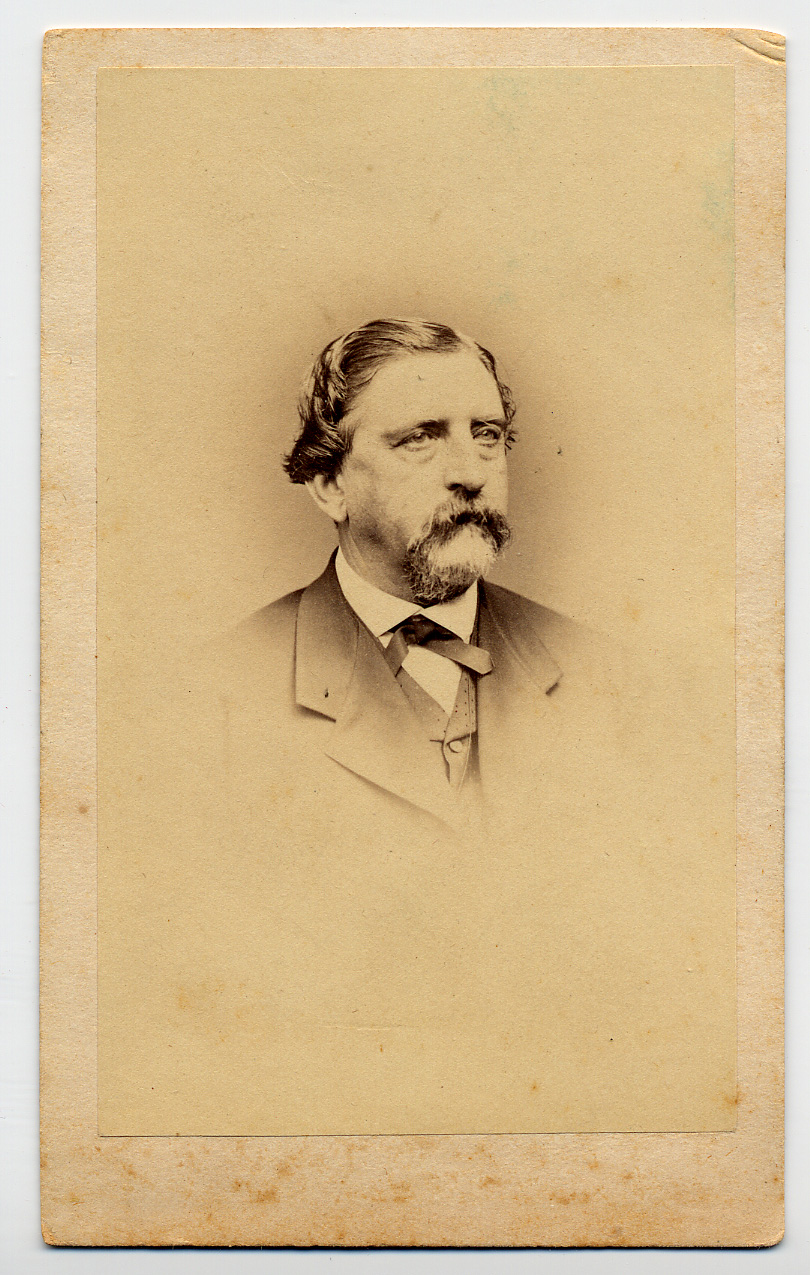
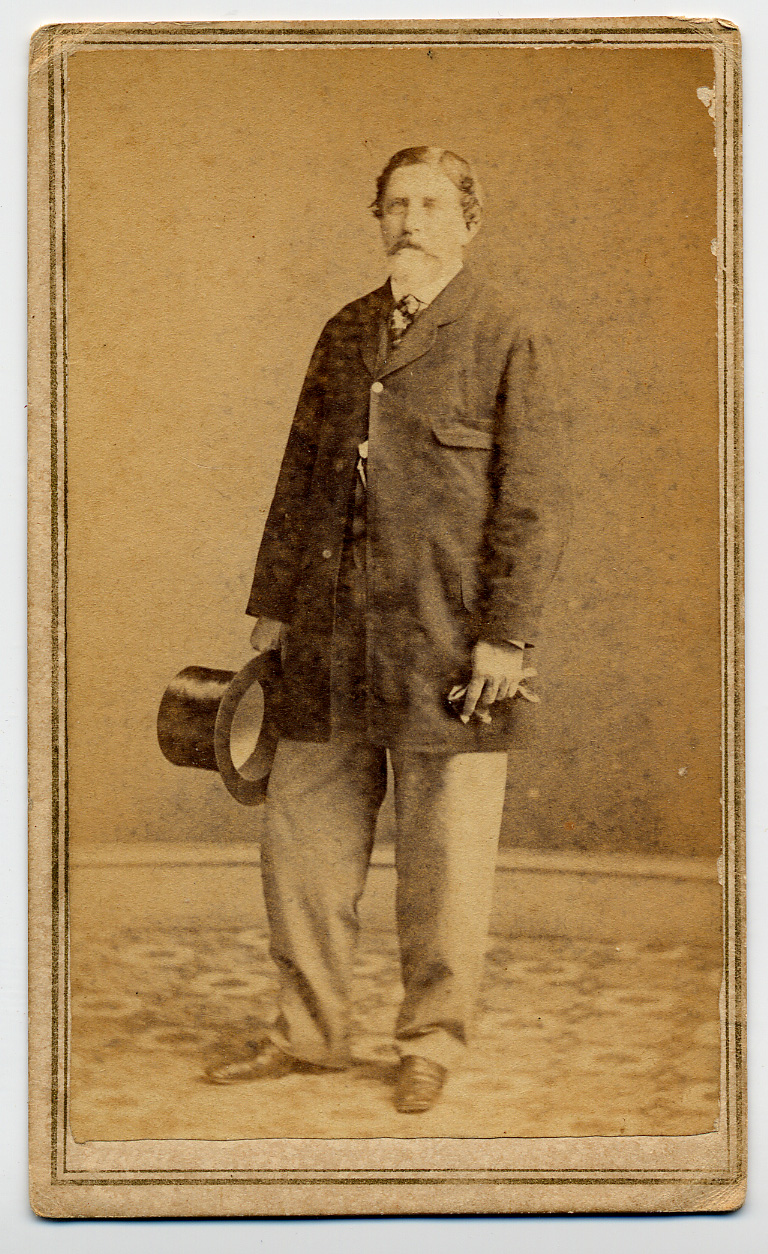
James B. Walton reorganized the
artillery unit after the war, then retired at age 64.
In 1877 Colonel Walton retired, and
Colonel William Miller Owen, adjutant during the Civil War, assumed command.
Being an independent command, the battalion purchased and paid for by
subscription a sufficient number of rifles and equipment to arm the unit that
same year, including the four 10-pound Parrott cannon and two 12-pound bronze
Howitzers still in New Orleans today.
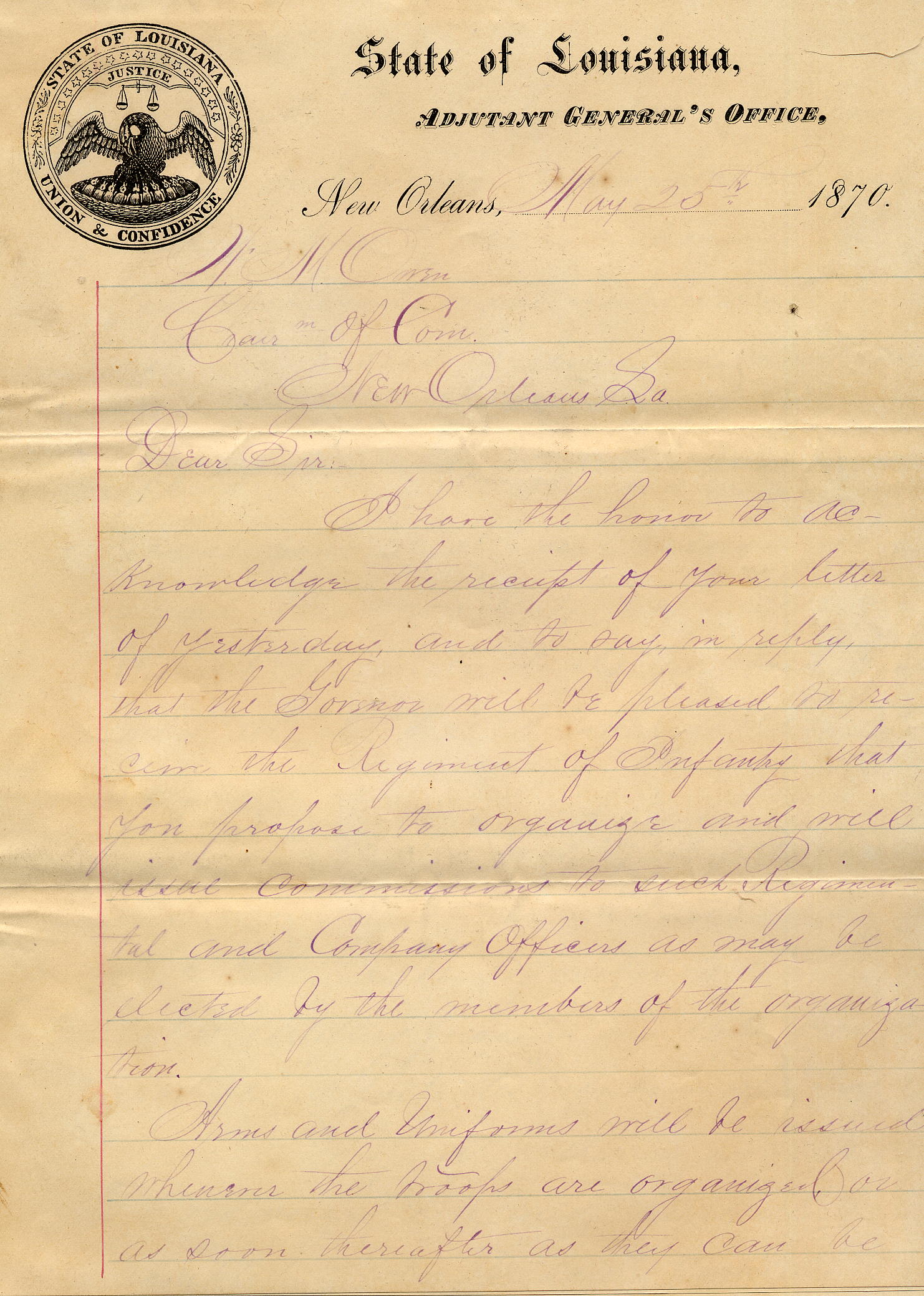
Letter dated May 25, 1870 from James Longstreet,
then Adjutant General of the State of Louisiana,
to William Miller Owen, announcing the acceptance
of his regiment back into the service of the state militia .
It reads in part, "I have the honor to acknowledge the
receipt of your letter of yesterday and to say in reply that the Governor will
be pleased to receive the regiment of infantry that you propose to organize.
Arms and uniforms will be issued whenever the troops are organized, but only one
artillery regiment of three batteries is authorized by militia law."
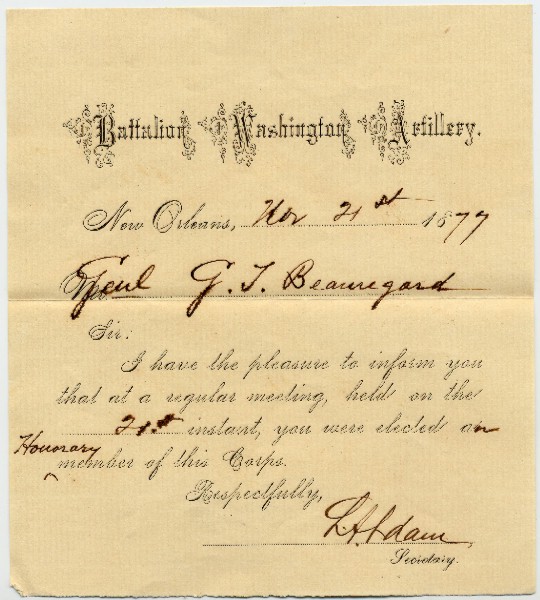
Letter
dated November 21, 1877 informing General G. T. Beauregard of his election to
the roles of Honorary Membership of the Washington Artillery
During the yellow fever
epidemic of 1878 in New Orleans, the command formed a relief corps to care for
the sick and bury the dead. In 1879 one battery was sent to St. John's Parish
during labor troubles. In 1880 the Benevolent Association of the Washington
Artillery raised the funds necessary to erect and complete the Washington
Artillery monument in Metairie Cemetery, which was dedicated on the 40th
anniversary of the unit, February 22, 1880. In 1881 Lieutenant Colonel John B.
Richardson replaced Owen. Richardson would reign as commander for the next
twenty-six years and was instrumental in securing the old Exposition Hall on
Saint Charles Street as a new arsenal, aptly renamed Washington Artillery Hall.
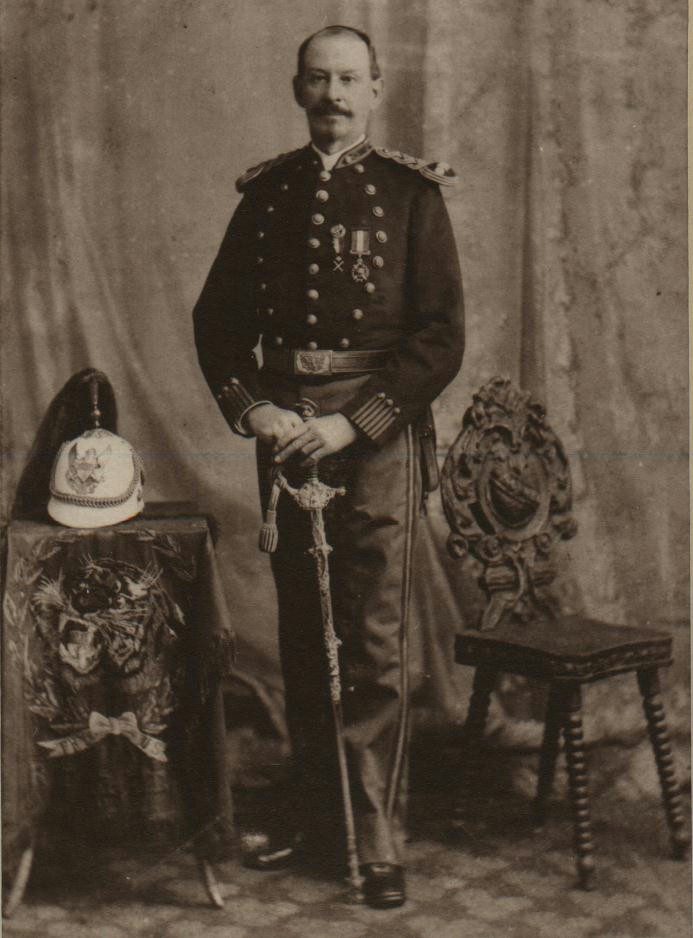
J. B. Richardson
The battalion was ordered to New Iberia in 1884 to assist in taking
possession of the Court Building and aiding authorities in enforcing the laws
and to Lafourche Parish in 1887 during labor troubles there. A great labor
strike also occurred in New Orleans in 1892. The Washington Artillery helped to
protect the Gas Works in the city from sabotage.
In order to keep the unit sovereign and from becoming part of the state
militia, Richardson asked then Governor Murphy Foster to accept the unit as
an "independent company" just as it functioned during the Civil War. So in 1893, Governor Foster designated that
the Washington
Artillery remain an independent command and assigned the battalion the official title of the "Governor's Body Guard."
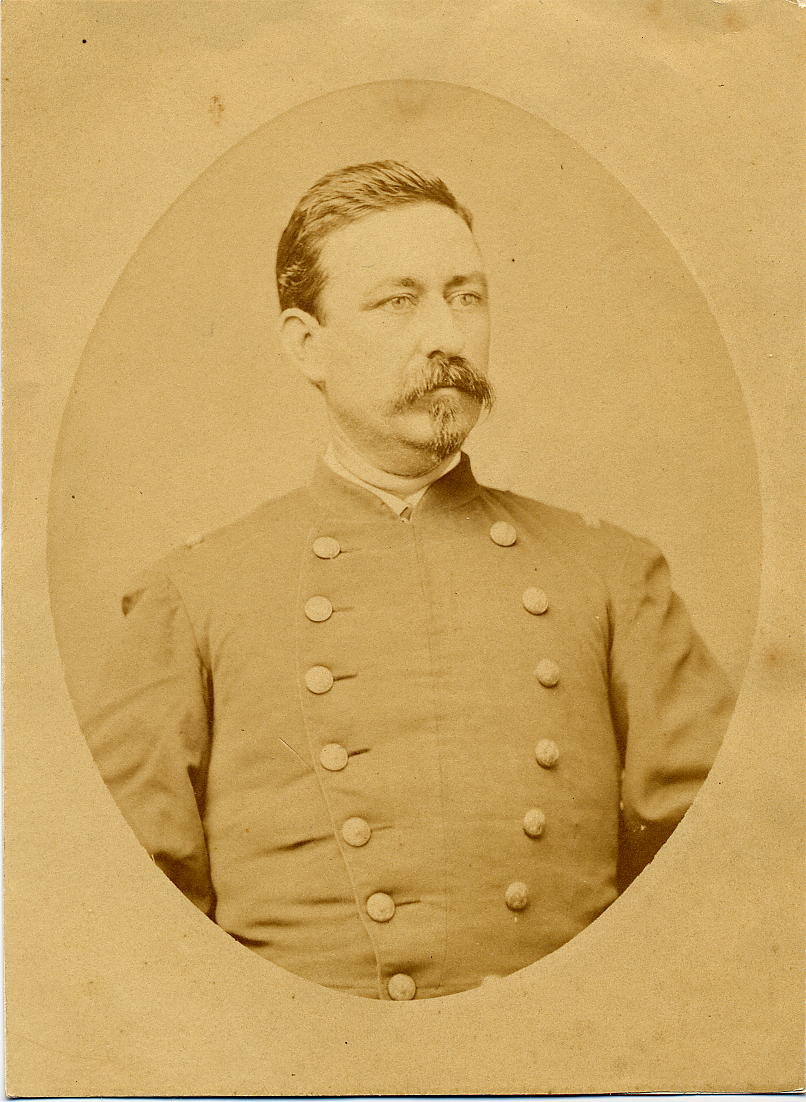
Etienne Pierre Cottreaux
Washington Artillerist placed on the staff of
Louisiana Governor Murphy Foster
(Cottreaux served in the 5th Company,
Washington Artillery during the Civil War.)
During the 1880s the Louisiana
militia consisted of three battalions of artillery: The Louisiana Field
Artillery, the Washington Artillery, and the Donaldsonville Cannoneers.
During the days of interstate competitive drills, the Washington Artillery,
under Captain Eugene May, took first prize at Dubuque in 1884, Mobile and
Philadelphia in 1885, Galveston in 1886, and Austin in 1888.
In 1898, the United States
entered into war with Spain. One battalion of artillery was requested from the
State of Louisiana. Volunteers from the three active artillery organizations
within the state volunteered one battery each. The Louisiana Field Artillery
provided Battery A, the Washington Artillery
provided Battery B, and the Donaldsonville Cannoneers, Battery C.
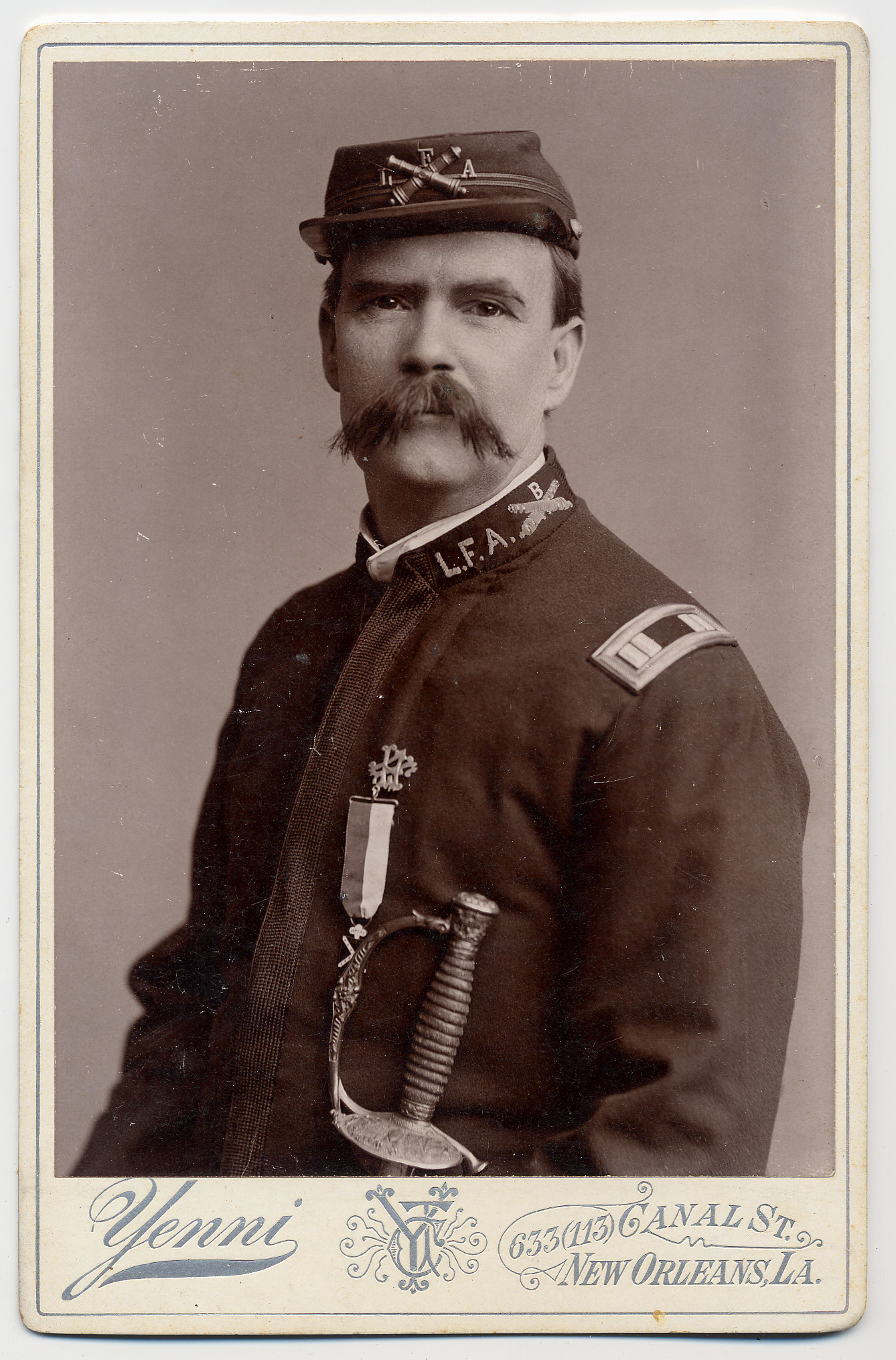
Captain Francis M. McKeough, Battery B, Louisiana
Field Artillery
(McKeough, an 18 year-old sergeant in
the 5th Louisiana Infantry during the Civil War,
was wounded at Sharpsburg and captured at
Petersburg. He wears his UCV badge. Photo circa 1875-80)
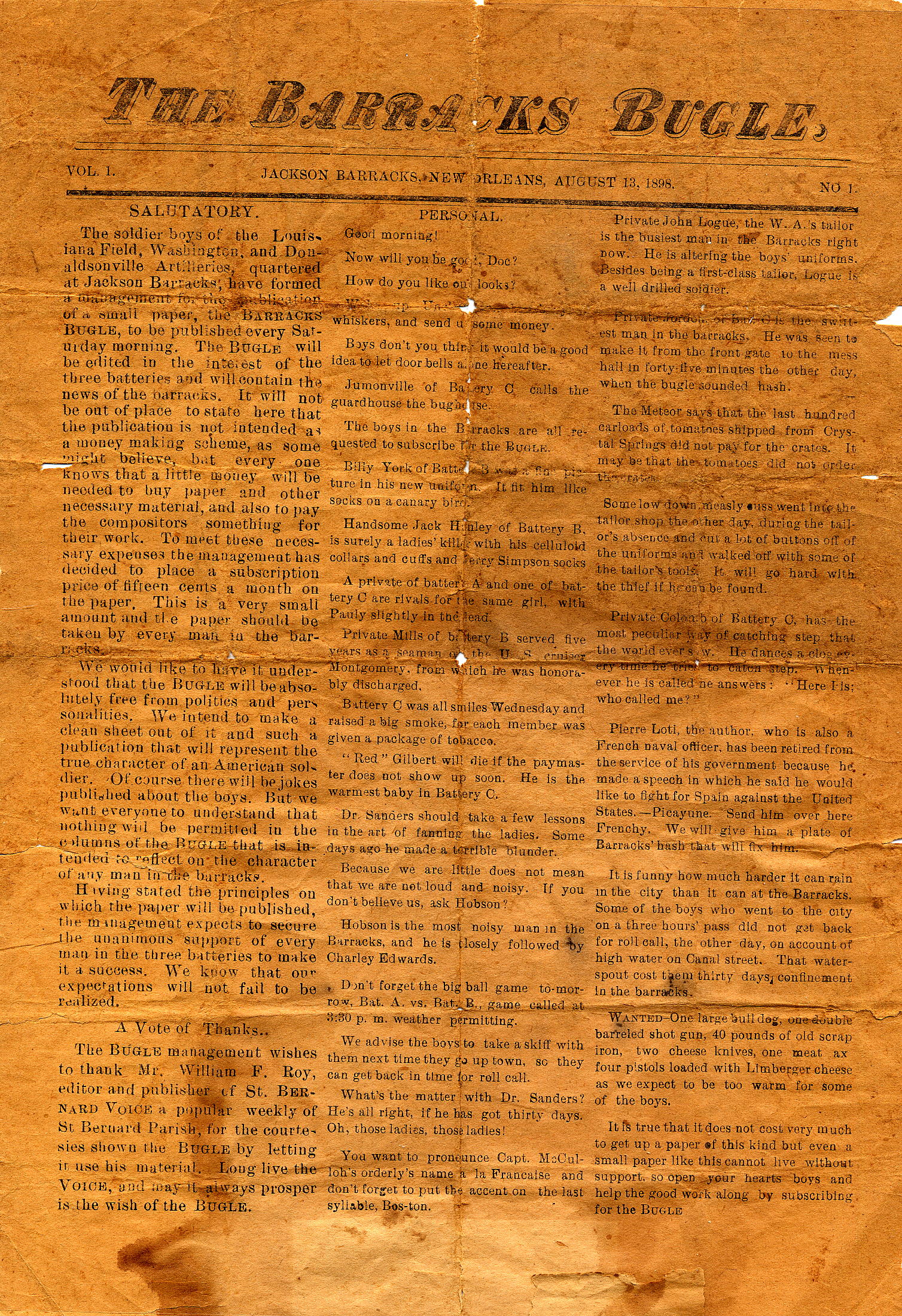
Rare first edition copy of The Barracks
Bugle newsletter No. 1 dated August 13, 1898
giving information about the soldiers of the
Louisiana Field, Washington, and Donaldsonville Artilleries, all quartered at
Jackson Barracks.
The Washington
Artillery volunteer battery provided for the Spanish American War in 1898 was commanded by
Captain Fred Kornbeck and was
designated as
Battery B, Louisiana (Volunteer) Field Artillery.
It was mustered into service on July 6, 1898. However, the new unit was still
fielding antiquated field equipment (10 pdr Parrot cannon), while the US
regulars were using modern French 75mm cannons. Therefore, the unit did not see
service outside of the United States, as the five-month long war ended before
the Louisiana artillery
was better equipped for the field. However, while assigned to Camp Cuba Libra,
near Tampa, Florida, Washington Artillery members of Battery B invented a new
alcoholic drink, known today as the "Cubra Libra" (Free Cuba), otherwise known
as "rum and cola with twist of lime." The Washington Artillery's battery was mustered out of Federal service on
November 12, 1898 at New Orleans. Following the Spanish American War, the
Washington Artillery again expanded to five batteries in 1899.
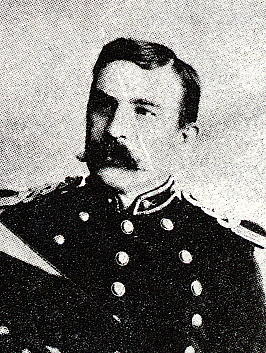
Captain Fred Kornbeck
The traditional, independent
character of the Washington Artillery would change forever after the turn of the
century. In 1903 the United States Congress passed the Dick Bill, which
established what we now know as the modern day National Guard. Uniformed militia
units were forced to become part of this national group and forfeit their
independent identity or lose federal/state funding. (Charles Dick, a
Congressional representative from Ohio, was largely responsible for the
emergence of the National Guard as a distinct national force supported by
federal resources and technology. His act required that all states must upgrade
their own organized militias to meet federal army standards. Many states and
local militia felt threatened by this act. Upgrading weaponry would be expensive
and militia officers were subject to replacement by those of the regular army.) Fearing loss of its
heritage, the Washington Artillery under J. B. Richardson was mustered out of
state service and existed at its own expense.
The battalion lost Commander
Richardson to time in 1906, and its new commander, Major W. D. Gardner, soon
took the position of brigadier general of the state militia outside of the unit.
He was replaced by Major Thomas Hyman on May 15, 1907. Hyman died on July 1, 1909 and was succeeded
on November 17th of the same year by
Major Allison Owen, son of the Civil War Adjutant.
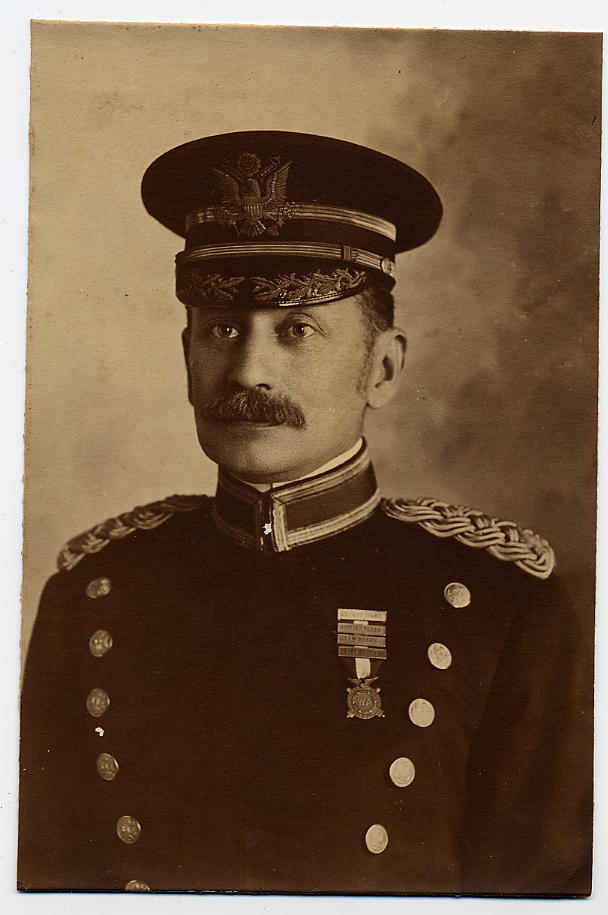
Allison Owen
Owen realized that the unit
was declining as an independent unit, having only two batteries under Hyman, and
convinced the organization that the Dick
Bill was not harmful to the organization and on December 13, 1909 had the unit
inspected by Captain Fred T. Austin of the Third US Field Artillery, who accepted three batteries of the
Washington Artillery into service within the Louisiana National Guard
on December 13, 1909 as the
Battalion Washington Artillery. Owen oversaw the
unit’s 470 men and 17 officers and continued the battalion’s reputation of
artillery skills, winning nationally recognized artillery competitions. Under
Allison's supervision, the unit entered an era of rebuilding. Captain
Stanley Lemarie served as adjutant. Captain Schaumberg McGehee commanded Battery
A, Captain James E. Edmonds- Battery B, and Captain Bryan Black- Battery C.
During its years of peace
service, the battalion performed "riot duty" both in New Orleans and other parts
of the state. In 1912 it was called to oversee refugee camps for flood sufferers
along the Mississippi River located at Vicksburg, Baton Rouge, Milliken's Bend
and other points.
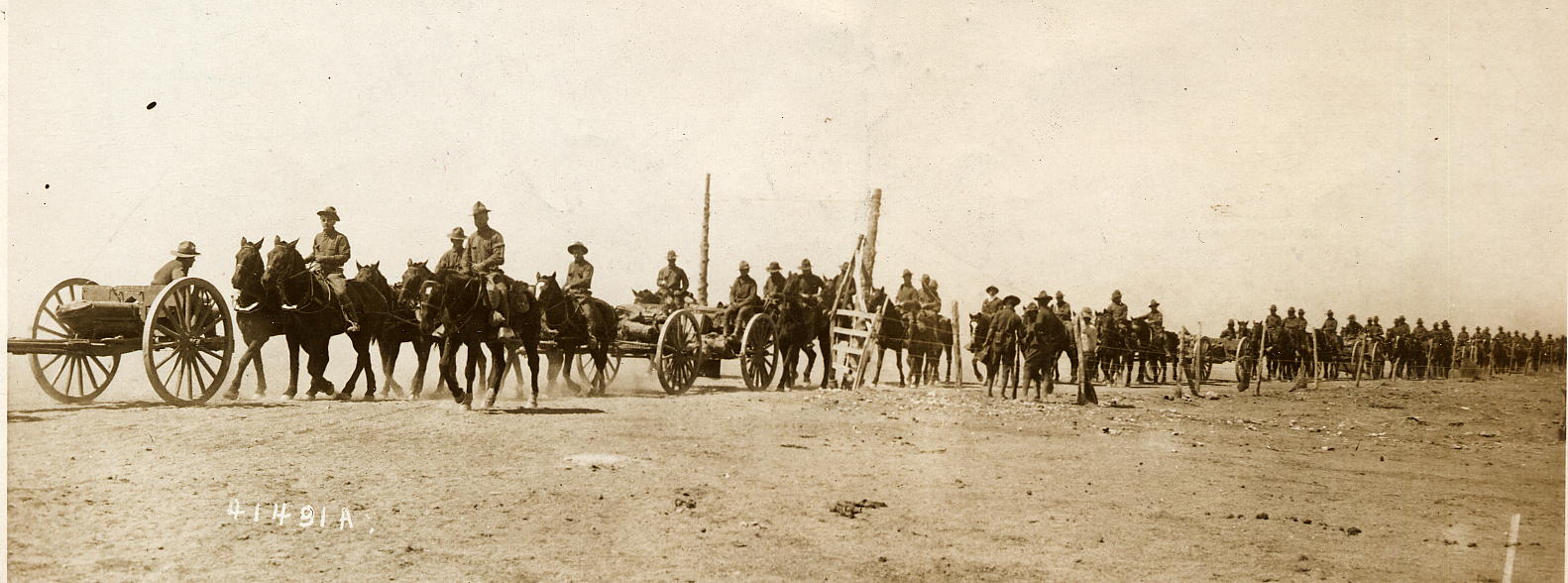
The Washington Artillery
on the Mexican border
When the Mexican Revolution of
1913-1917 erupted, the Washington Artillery
remained in New Orleans during most of the conflict , but
eventually became part of the U.S. forces sent to the American/Mexican border to
protect American lives and property. As various political and social factions
within Mexico fought to overthrow a 30-year dictatorship and establish a
constitutional republic, the revolution spread to that country’s northern
border where Francisco “Poncho” Villa, a Mexican revolutionary, raided
Mexican government garrisons to help arm his men. Angered by the American
government’s backing of his rival, Venustiano Carranzo, Villa also began raiding
across the American border. The Texas governor threatened reprisals against
Mexico by his Texas Rangers, and the United States government was forced to send
the National Guard to patrol the Mexican border. The American government was
forced to take action when Poncho Villa rode into the town of Columbus, New
Mexico and killed 18 Americans. In a futile and unsuccessful attempt to catch
Villa, American President Woodrow Wilson sent a force led by John J. Pershing
into the Mexican hills to capture him. This time of tension between Mexico and
the United States reached its peak after the shelling and occupation of Vera
Cruz, Mexico by U.S. forces.
On June 18, 1916
President Woodrow Wilson ordered the mobilization of the whole National Guard of
the country. The following day, members of the Washington Artillery assembled at
their armory and were
mobilized as part of the Louisiana National Guard for duty along the Mexican
border that same day. The unit was stationed at Camp Stafford in Alexandria, Louisiana, where
it was assigned the name the
First Battalion, Louisiana Field Artillery
(Washington Artillery). It was composed of the
following: Field & Staff (3 officers, 4 men), Battery A (5 officers, 159 men),
Battery B (5 officers, 132 men), and Battery C (5 officers, 149 men). From Camp
Stafford, the unit was sent to Donna, Texas, arriving on July 18, 1916, as part
of the 13th Provisional Division, with headquarters at Llano Grande, and
commanded by Brigadier General James Parker. The unit was part of the command
needed to guard the American/Mexican border near Brownsville,
six miles from the Rio Grande River. It relieved American troops ordered from
that position into Mexico in pursuit of Poncho Villa. The Washington Artillery
was mustered out of Federal service on Mardi Gras Day February 28, 1917.
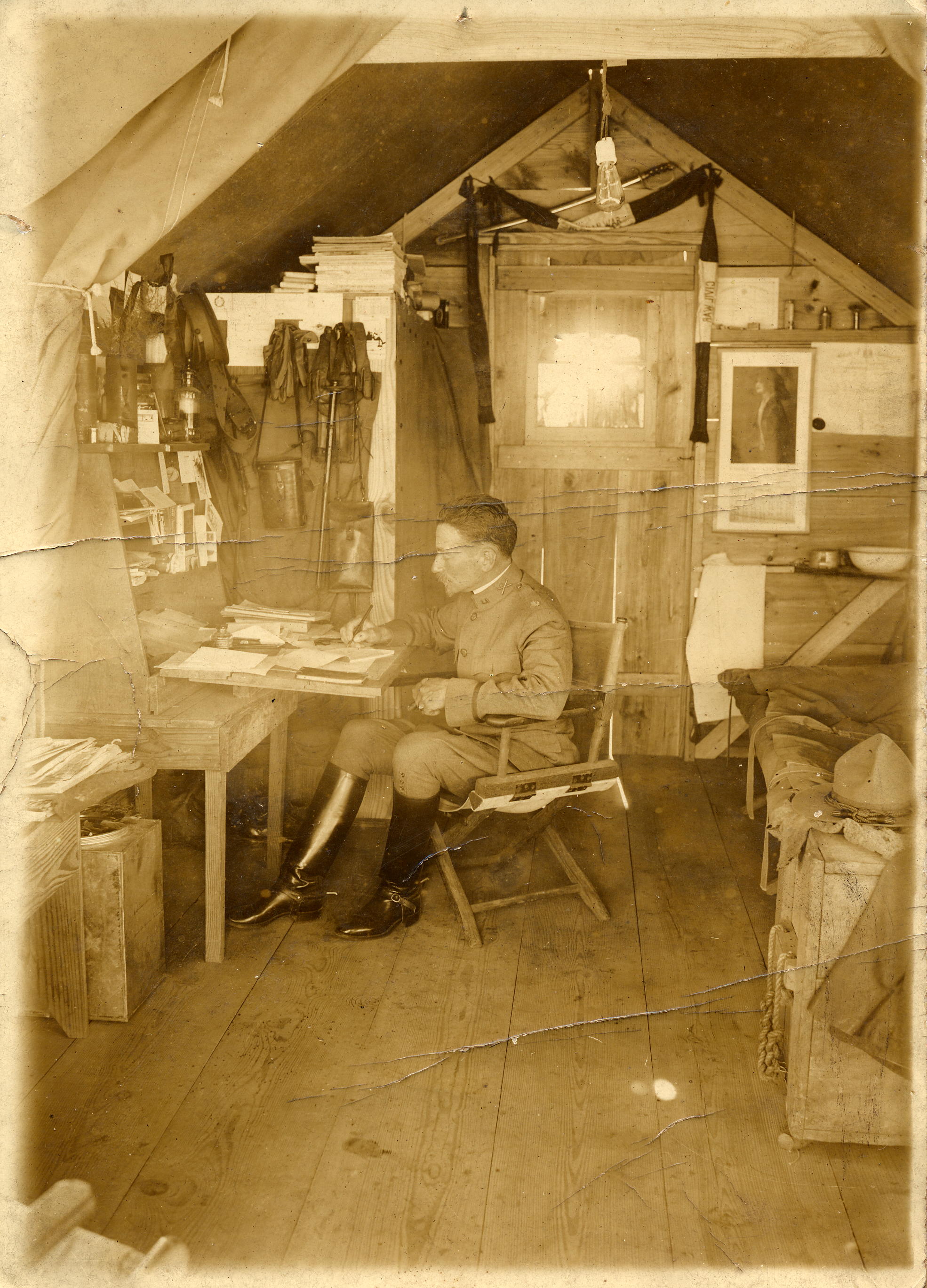
Major Allison Owen in his quarter's on the Mexican
Border
After a mere 28 days of its
"hero's welcome" home from Mexico, the services of the battalion
were once again needed when American diplomatic relations with Germany were
severed in March of 1917. The State of Louisiana ordered the mobilization of the
Washington Artillery on March 28th, the sixth time in its career. Washington
Artillerymen served to protect the ammunition stores moving through the port of
New Orleans. The United States declared war on Germany on April 6, 1917
following the sinking of the USS Lusitania,
at which time the men of the command went into training at Camp Nichols. The
battalion was expanded and mustered into Federal service on April 20, 1917 as
the First Louisiana Field Artillery. On April 19, 1917, the command was mustered
into service as follows: Field & Staff (3 officers), Headquarters Company (12
men), Supply Company (1 officer & 3 men), Battery A (5 officers & 188 men),
Battery B (5 officers & 168 men), and Battery C ( 5 officers & 188 men). The
battalion was transferred to Camp Beauregard on
October 15th as part of the 64th Field Artillery Brigade
of the 39th Division under Brigadier General Ira H. Haynes and Major
General H. H. Hodges. Here, the organization was given a new designation, the
141st Field Artillery, on September 27, 1917. Seventy-five French
speaking members of the newly named Washington Artillery were sent to France as
military police in 1918.
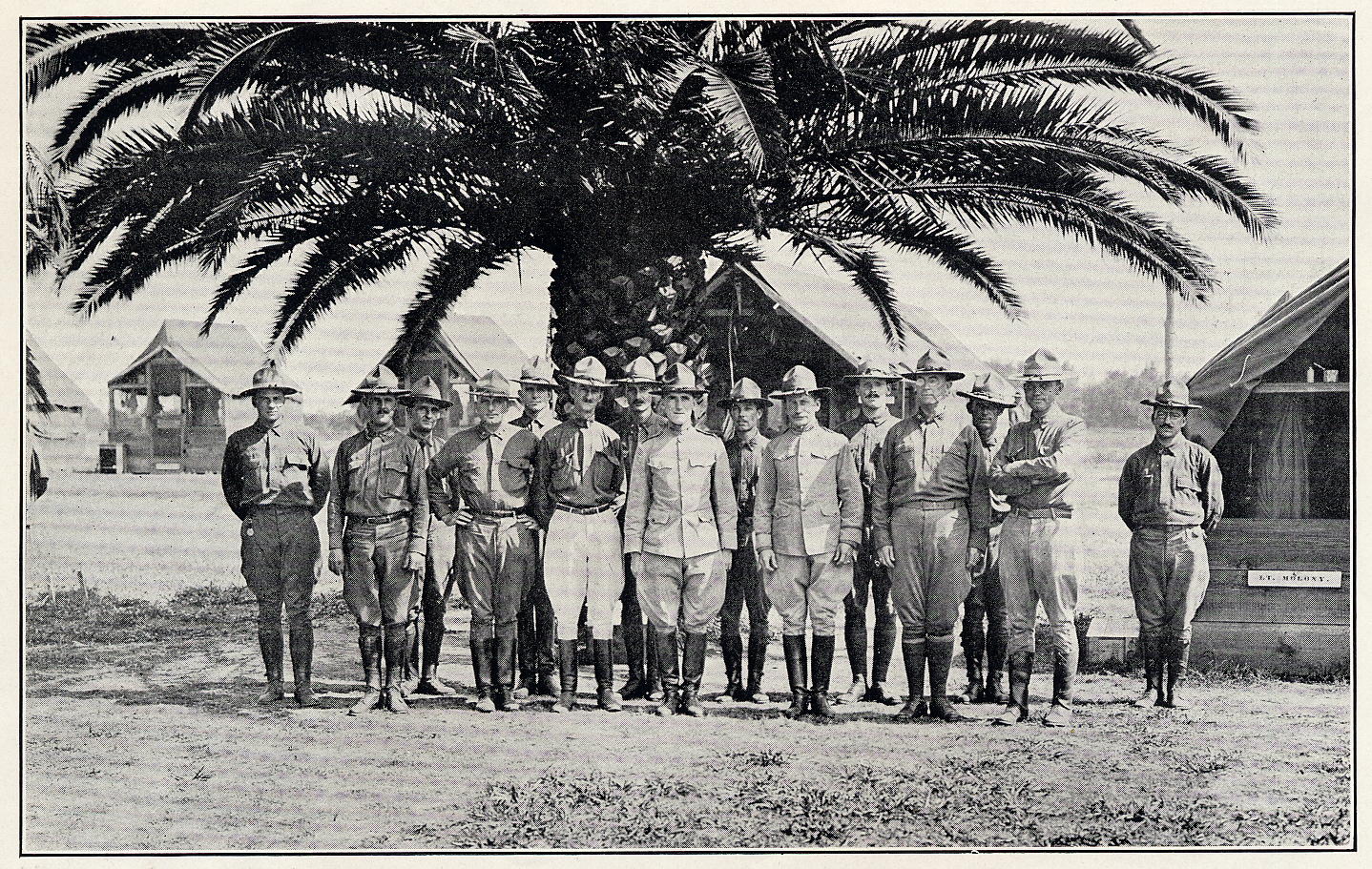
Major Allison Owen, Staff and Line Officers 1917
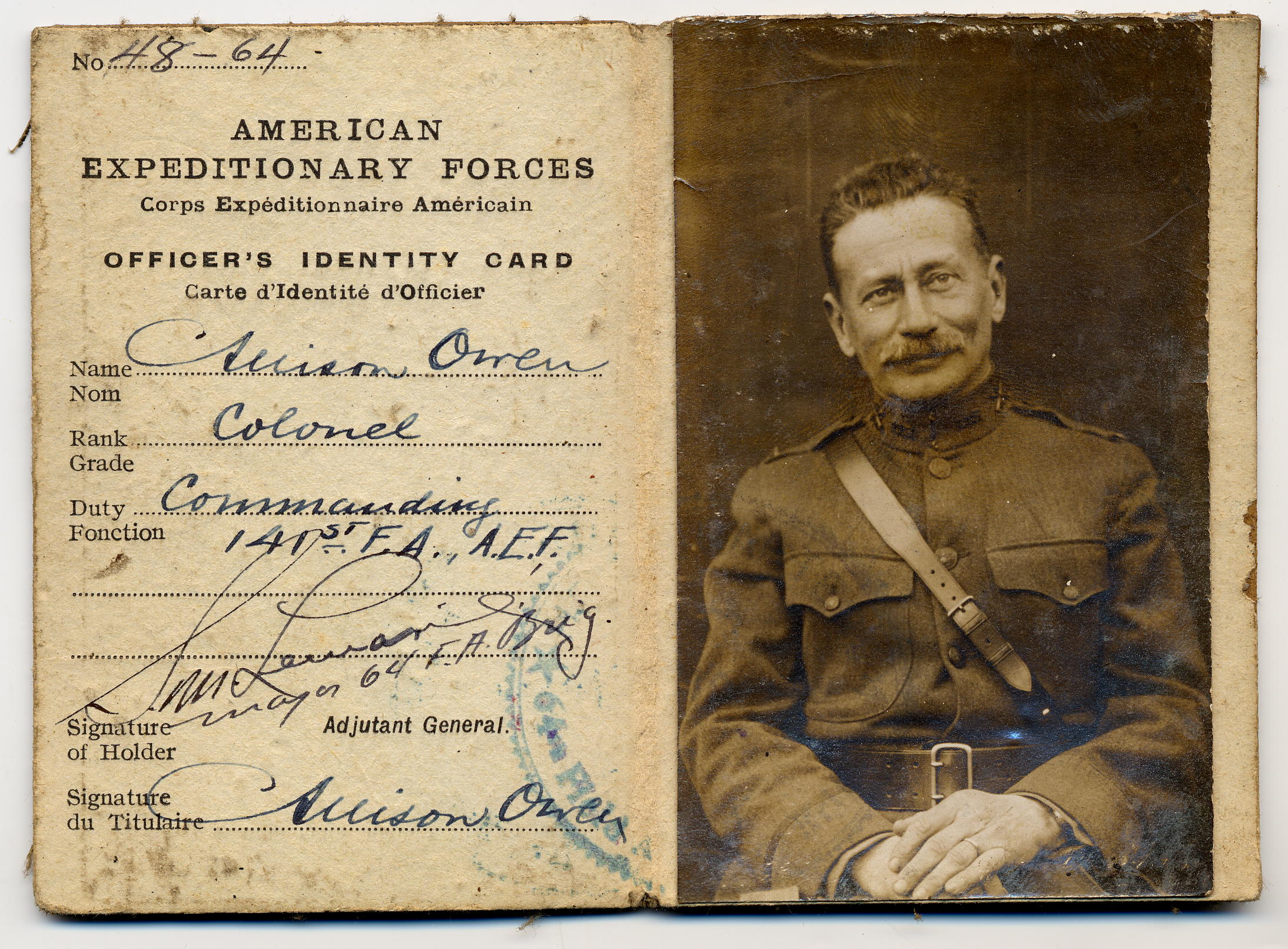
Colonel Allison Owen's 1918 military Identification card
The entire regiment (now 1,400
men strong) soon followed on August 26, 1918, sailing for France on the North
German Lloyd liner Kaiser Wilhelm II,
rechristened the Agamemnon, and
arrived in Brest, France on September 3rd. It was here that American field
artillery units were given their training under the direction and influence of
the French army. As a result, the basic artillery guns used by the American Army
from WWI up until the beginning of WWII were the French 75mm cannon, the French
155mm Schneider Howitzer, and the French 155mm GPC gun. The Washington Artillery
trained in the use of the French 75mm guns, but did not see battle action during
World War I as the armistice was signed prior to their engagement. While in
France the unit received a telegram from the War Department authorizing the use
of the name
“Washington Artillery”
in addition to its numerical designation “141st”. The Washington Artillery
arrived back in New Orleans on April 28, 1919, along with their French 75mm
cannon. Its members were mustered out of Federal service May 3, 1919 at Camp
Shelby, Mississippi.

Battery B, 141st Field
Artillery upon arrival back to the states from its overseas
WWI expedition
Notice original WA Tiger
flag (first row, center), used during the Mexican War
The battalion reorganized on
November 25, 1920 under the National Defense Act as
Battery A, Field Artillery
of the Louisiana National Guard with Colonel Allison Owen, Captain Raymond H.
Fleming, Colonel James E. Edmonds, and Colonel Frank D. Molony active in its
rebirth. It was commanded by Captain Luther E. Hall with Lieutenants Paul
Loeblich, Thurber Richey and Henry B. Curtis. Later that year Battery B was
formed.
As the National Guard matured,
state units were often reorganized and renamed. The Washington Artillery was no
exception. It would undergo a series of redesignations; Batteries A & B,
First Battalion, 141st Field Artillery on November 25, 1921;
Batteries D & E, Second Battalion, 141st Field Artillery on
January 7, 1922; Second Battalion, 141st Field Artillery on May 2,
1922; and First Battalion, 141st Field Artillery on June 27, 1922. In
1926 still another name change followed, the
167th Separate
Battalion, Field Artillery (Horse). However, the latter name change was met with
opposition from the unit. A petition to the War Department was submitted in
1927, the result of which granted the reinstatement of its older “141st”
name.
In 1935 the
1st
Battalion, 141st Field Artillery was motorized with the gradual
replacement of its horses. On December 13, 1936 a Coat of Arms was designed for
the organization. It was composed of a shield within which contained a tiger’s
face with the motto “Try Us” beneath. The shield was red for artillery and
the tiger’s face appeared as it had since the organization’s founding. On
February 22, 1939 the battalion celebrated its 100th year anniversary
in New Orleans by firing one round over the Mississippi River every hour for 100
hours. On October 2nd of that same year the War Department confirmed
to Congress the unit’s entitlement to have the designation
“Washington Artillery”
in parenthesis behind its numerical designation and approved the unit’s shield
and motto of the coat of arms for use as a distinctive insignia.
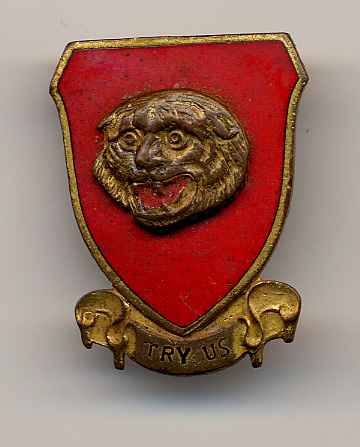
WA Coat of Arms insignia
The
141st Field
Artillery (Washington Artillery), Lt. Col.
Henry B. Curtis now commanding, became part of the 73rd Field
Artillery Brigade on September 23, 1940. The
73rd Field Artillery Brigade was composed of three State National
Guard units; the 166th and 190th Field Artillery Regiments
from Pennsylvania, and the 141st (Washington Artillery) from
Louisiana. Soon, inter-regimental rivalry erupted when the tune “Dixie”
became the Washington Artillery’s regimental song, a thorn in the side of the
northern regimental units of the brigade.
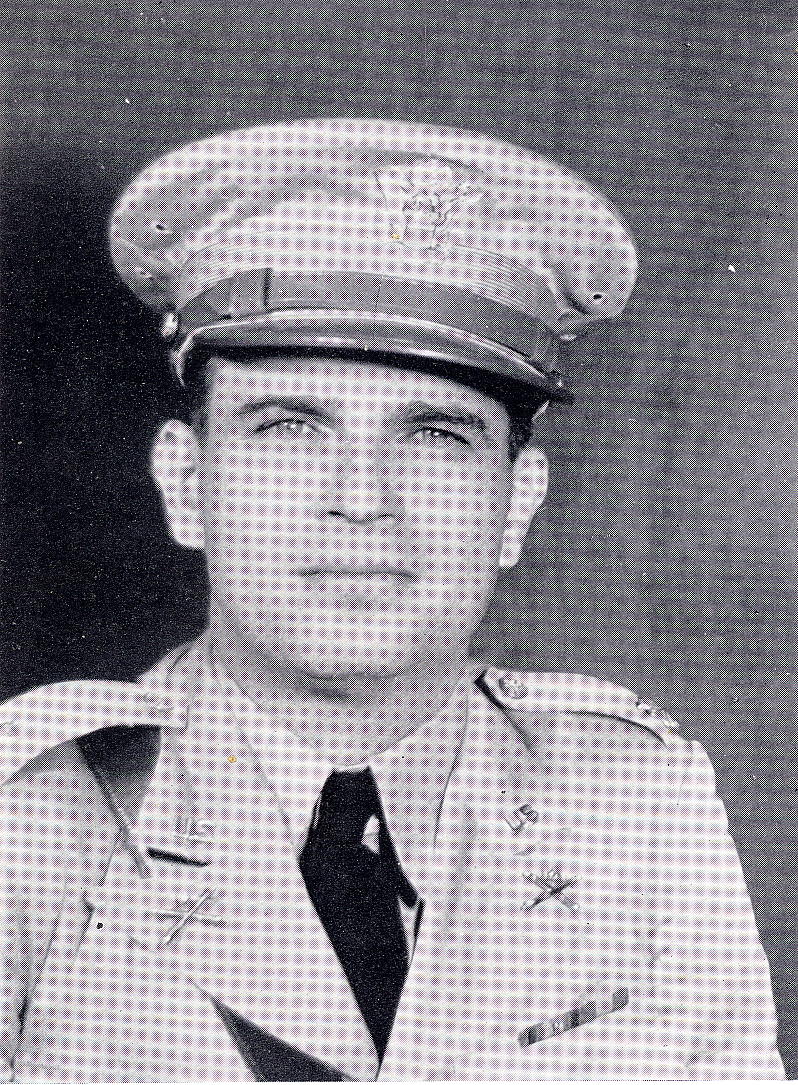
Henry B. Curtis
Lieutenant Colonel, Commanding
141st FA, 1938
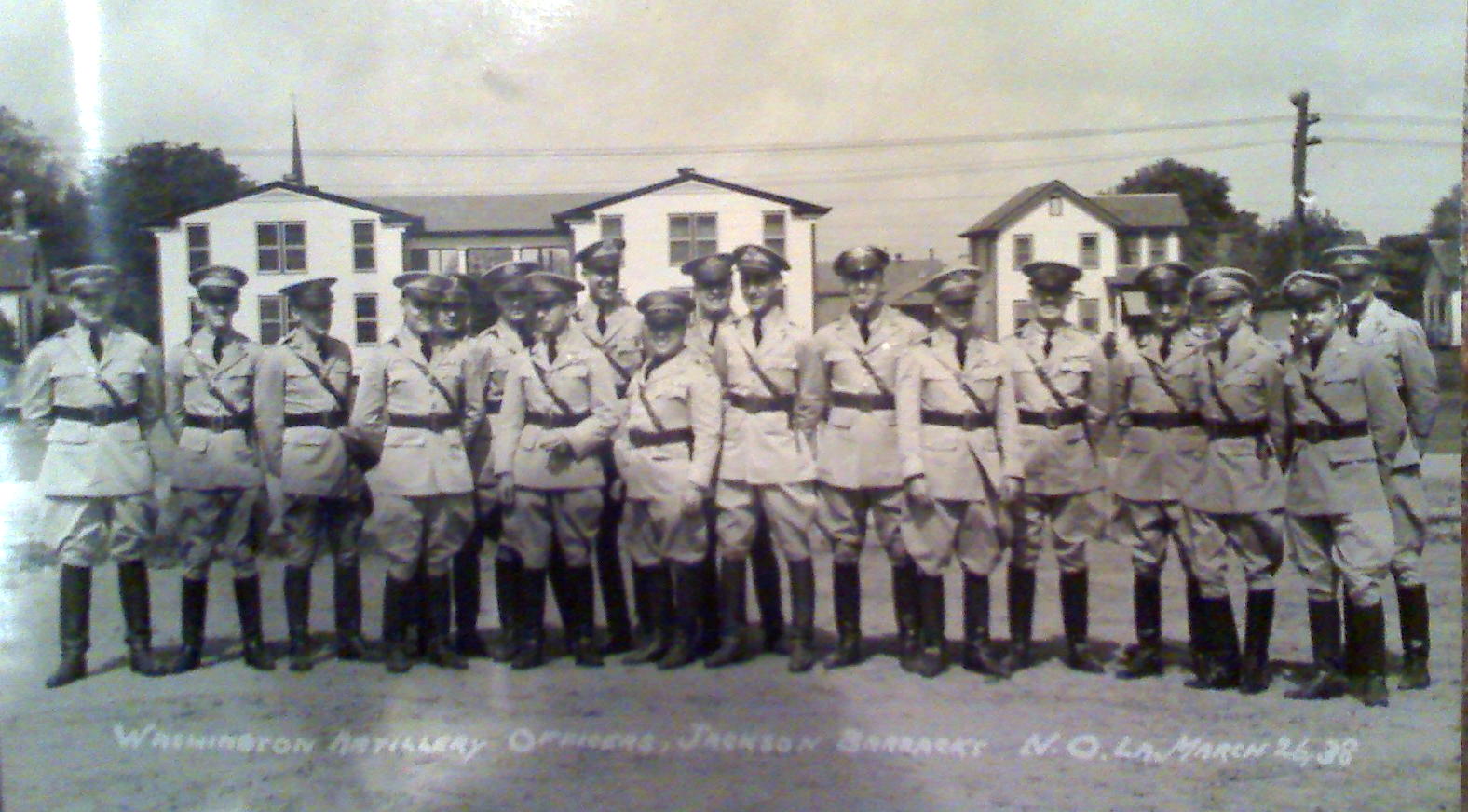
Washington Artillery officers,
Jackson Barracks, NOLA, March 26, 1938
In October of 1940 Japan
signed a pact with Germany, a sign of possible future military action for
America. On December 20, 1940 the Washington Artillery was converted from its
75mm gun regiment to a 155mm howitzer regiment of corps artillery, and its
cavalry attachment retired. It was inducted into Federal service on January 13,
1941 at New Orleans. The first member of the unit called into service was
Captain Robert H. Wilson, a World War I officer in the regiment, who arrived at
Camp Shelby near Hattiesburg, Mississippi prior to the transfer of the remaining
battalion to that location. Lt. Col. George W. Winton of the Regular Army, who
had served as the battalion’s instructor, handled the mustering of each
battery. The newly changed unit spent the next 12 months at Camp Shelby
undergoing field artillery instructions. During that time of instruction, the
141st took part in war games at the newly established Camp Polk near Leesville
in southwest Louisiana. General George Patton was an aggressive commander during
those maneuvers. The 141st left the area on October 9, 1941 and returned to Camp
Shelby.
The light-hearted atmosphere
experienced during those war games soon changed to seriousness following the
Japanese attack on Pearl Harbor on Sunday, December 7, 1941 and left little
doubt as to why the Washington Artillery had been called to active duty.
Immediately, 40 men from
Batteries G & H of
the 141st were transferred to a newly
created provisional anti-tank battalion designated as the
773rd Tank
Destroyer Battalion
and re-designated as Batteries A & B.
[Under
the aggressive
leadership of
Lt. Col. Frank G. Spiess, the
773rd would attain an outstanding
combat record in the European Theater and win the Presidential Unit Citation. No Tank Destroyer unit in Europe had a better combat
record than the 773rd, destroying 113 tanks, 25 SP guns, and 105 pill boxes. It
fired 8,219 rounds in direct fire, took 1,970 prisoners, and spent 254 days in
combat
- a truly remarkable record.]
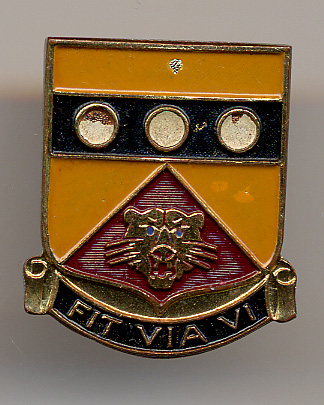
773rd Coat of Arms insignia
A tiger head within a shield with Latin motto
"Fit Via Vi"
From Book II of the Roman poet Vergil's epic 'The Aeneid', "Fit Via Vi" may be translated
"The way is
forged by strength"
The remaining Washington Artillerymen were divided among two battalions. Lt.
Col. Edward Benezech, Sr., a 26-year veteran of the Washington Artillery
commanded the First Battalion and over saw Batteries A, B, C, & G. The
Second Battalion was lead by Lt. Col. Thurber Richey. A member of the Washington
Artillery since 1917, Richey commanded Batteries D, E, F, & H.
However, the advent of World
War II saw the transfer of many WA officers to other units, including the above
mentioned colonels. Except for during World War I, the Washington Artillery had
always drawn its officers from its own ranks. (In order to avoid disciplinary
problems within a battery, a newly commissioned officer was sent to a different
battery of the organization from which they initially served.) This time-honored
policy proved detrimental to the command structure of the expanding modern
organization. Highly trained ROTC graduates would have to volunteer as privates
and work their way through the ranks for many years before receiving a chance at
becoming an officer within the organization. This tradition could not be
tolerated in WWII, and the regiment was quickly “contaminated” with
nonmembers. One such nonmember was the unit’s new brigade commander, Thomas
Jonathan Jackson Christian. Ironically, he was the grandson of the great
Southern Confederate General “Stonewall” Jackson. Although the Washington
Artillery had been historically linked with Southern General James
Longstreet’s Corps, its members had comfort in the fact that they would be led
into battle again by a descendant of so famous a leader.
A major change occurred on
March 7, 1943 when Federal orders changed the designations of the two regiments
within the brigade and implemented the organization of field artillery groups.
On March 7, 1943 the
141st Field Artillery was divided into four
sections: the command aspect of the organization became the
141st
Field Artillery Group (Headquarters & Headquarters Battery). Its First
Battalion was reorganized into the
934th Field Artillery Battalion,
while its Second Battalion was reorganized into the
935th Field
Artillery Battalion. These three components remained part of the 73rd
Field Artillery Brigade (Corps), V Corps. Batteries G & H of the Washington
Artillery were designated as anti-tank battalions and were transferred out of
the brigade into the 773rd Tank Destroyer Battalion. Each battery was
equipped with 50 men and 75mm guns.
Six months later the 190th
Field Artillery Regiment of the 73rd Field Artillery Brigade was
shipped overseas. However, the entire 141st and the 166th
remained behind as both were short of essential equipment and training to see
action just yet. The Washington Artillery then left the 73rd Field
Artillery Brigade, moving to Camp Gordon, Georgia, where it was reorganized into
the 141st Field Artillery Brigade. Here, it received a new commander,
Brigadier General George D. Shea, who replaced Christian. (Fate would not allow
the 141st to be led into battle by Stonewall Jackson’s grandson.)
The 141st’s men were issued their allotment of 30 caliber M1
carbines as personal small arms and new 4.5 inch guns for artillery use.
The Washington Artillery
transferred to Camp Polk, Louisiana on October 10, 1943 and was assigned to the
Headquarters of the XIX Corps Artillery. Frustratingly, the Washington
Artillery’s service in the U.S. Army from 1941-1943 may be summed up as one of
constant training, changes in designations, and transfers of personnel. The
designation for the 934th was changed once again back to the 141st
Field Artillery Battalion on July 30, 1943.
But
the time finally came in 1943 for the Washington Artillery to go overseas. The
141st Field Artillery Battalion and its sister battalion, the 935th,
left Camp Gordon, Georgia on August 12, 1943 to New York for transport overseas.
Both arrived to Oran, Algeria, North Africa on August 31, 1943.
From here the brigade separated. A convoy moved the 141st to a port in
Bizerte, Africa where it sailed again to Italy, arriving on November 19th
on the shores of Anzio, Italy. The 935th landed at Salerno, Italy on
October 11th. Just like in the American Civil War, the Washington Artillery
divided its forces against the enemy. The 141st would be attached to the U.S.
Army’s VI Corps; the 935th attached to the British 10th
Corps of the Fifth Army. The Washington Artillery would once again serve its
nation well in World War II.
After participating in the action
at the Anzio beachhead and near Casino, the 141st, along with Allied
Forces, pursued the German and Italian Armies northward and on June 5th, 1944,
became the first American Artillery unit to enter Rome. Meanwhile, the 935th,
saw heavy action at Monte Casino and advanced to enter Rome also on June 5,
several hours after the 141st.
Both battalions
participated in the push to force the German Army into their homeland. By the
end of the war, the 141st was near Munich and the 935th was at Augsburg. The
141st had been in combat 463 days and fired 150,871 rounds during 7,004 missions
and occupied 108 positions. The 935th fired in excess of 141,000 rounds during
8,845 missions, had been in combat 462 days and supported 18 divisions and six
different corps.
After World War
II, the Battalions of the Washington Artillery were released from active duty
and on November 8, 1946, were deactivated and placed back into the Louisiana
National Guard.
During the
1950s the Washington Artillery was increased to 3 battalions: the 1st, 2nd and
4th Howitzer battalions. During the 1960’s the battalions were consolidated,
forming the
1st Battalion,
141st Field Artillery. In
1971, the battalion was assigned to the 256th Infantry Brigade of the Louisiana
National Guard and was again officially recognized as the
1st Battalion,
141st Field Artillery (Washington Artillery)
by the State Department.
In 1978, the
256th Infantry Brigade, including the Washington Artillery, was attached to the
5th Infantry Division Mechanized (5th I.D. [M]) as a part of the “Round-Out”
brigade. During this time, the Washington Artillery turned in their traditional
towed howitzers and were given the new M109A1 (155mm) self-propelled howitzers.
In December
1990, the Battalion Washington Artillery was mobilized and entered Federal
Service during Operation Desert Shield and served at Fort Hood with the 256
Infantry Brigade while attached to the 5th Infantry Division and later with the
4th Infantry Division. When Operation Desert Storm ended with the surrender of
the Iraqi forces, the battalion was released from active duty.
After the
terrorist attack on New York's Twin Towers on September 11, 2001, the Washington
Artillery was deployed to provide security for several key infrastructure sites
in southeast Louisiana. In May 2004, the Washington Artillery was called into
service for Operation Iraqi Freedom. In
May 2004, the Washington Artillery was called to arms to participate in the
Global War on Terrorism as part of Operation Iraqi Freedom III. The Battalion
conducted its pre-mobilization training at Fort Hood, Texas just as it did in
Operation Desert Shield/Storm. The Battalion validated its training in a three
week Mission Readiness Exercise (MRE) at the National Training Center (NTC) in
the Mojave Desert of California then deployed to Kuwait. After 4 months of training at Fort Hood,
Texas and Fort Irwin, California, the battalion was deployed to Kuwait in
September of 2004.
While in Kuwait, the battalion spent three weeks preparing itself and organizing
into Task Force Thunder; one of the largest battalion sized units in theater
consisting of just over 740 Soldiers. The battalion conducted a three day
tactical road march into Baghdad, Iraq and immediately began combat operations.
The battalion had a myriad of missions with everything from artillery missions,
combat patrols, base defense and insurgent detainee operations through September
2005. The battalion was awarded the Meritorious Unit Citation for its stellar
performance as well as a Campaign Streamer for “Governance” for the battalion’s
role in the first Iraqi Democratic Election. It also received a Battle Streamer
for Operation Iraqi Freedom III.
Upon its
arrival back stateside in 2005, the battalion returned to the devastation
inflicted by Hurricanes Katrina and Rita. Those members able to remain on
active duty participated in the recovery efforts.
In October of
2006, the Washington Artillery was reconfigured, and the battalion turned in its
self-propelled howitzers for 105mm towed howitzers. The battalion, now under the
command of Lt. Col. Brian Champagne, carries on the rich history, traditions and
honor of its past and looks forward to serving its state and country
into the 21st
century....
"Fit Via Vi"
"Try Us!"
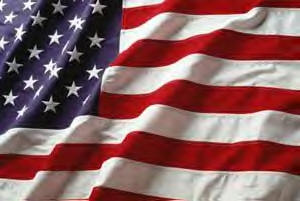
The Battle Honors of the
Washington Artillery, since its existence, earned the following Campaign
streamers:
Mexican War-1
Civil War- 14
World War I- 1
World War II- 8
Global War on Terrorism - 2
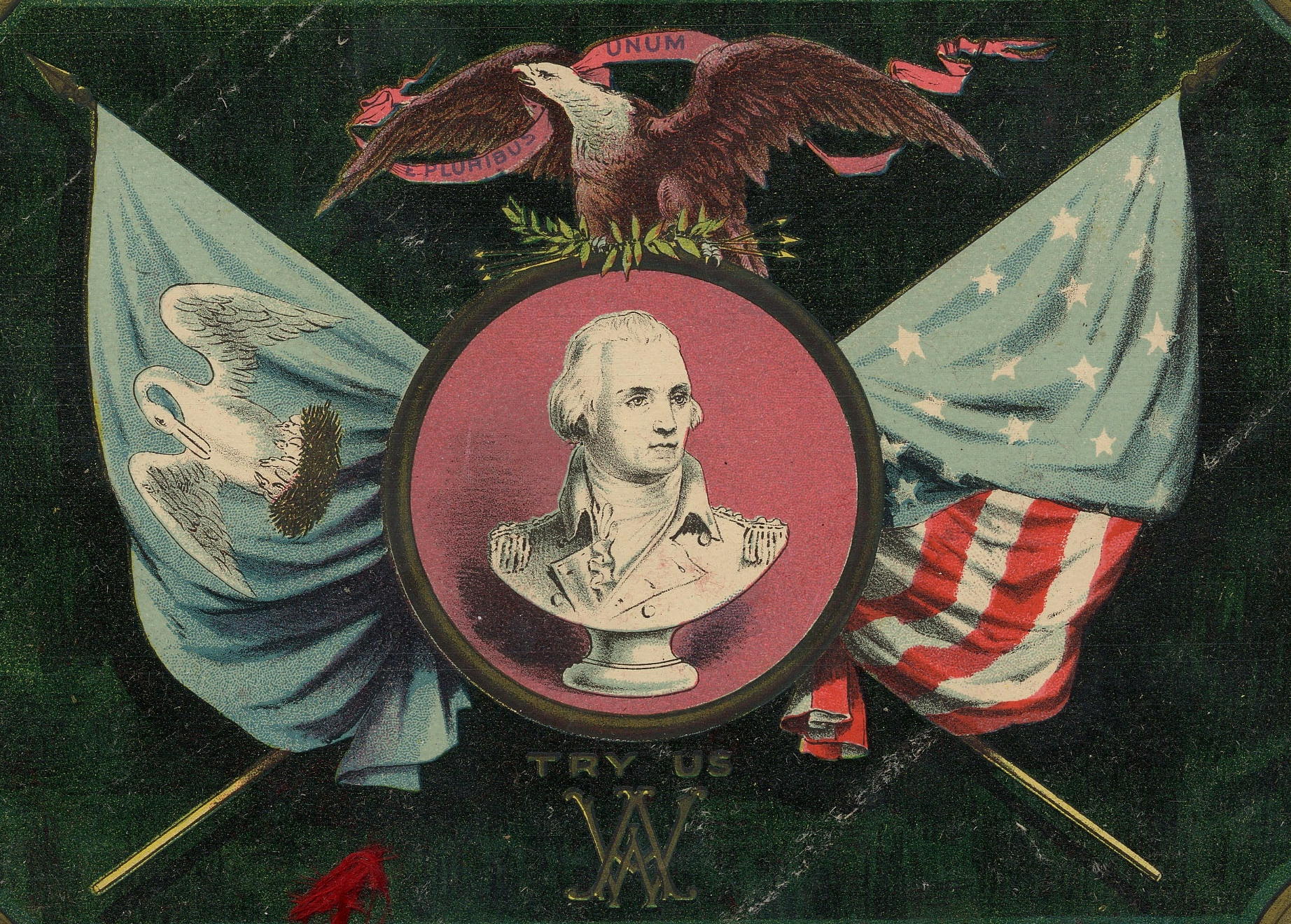
HOME